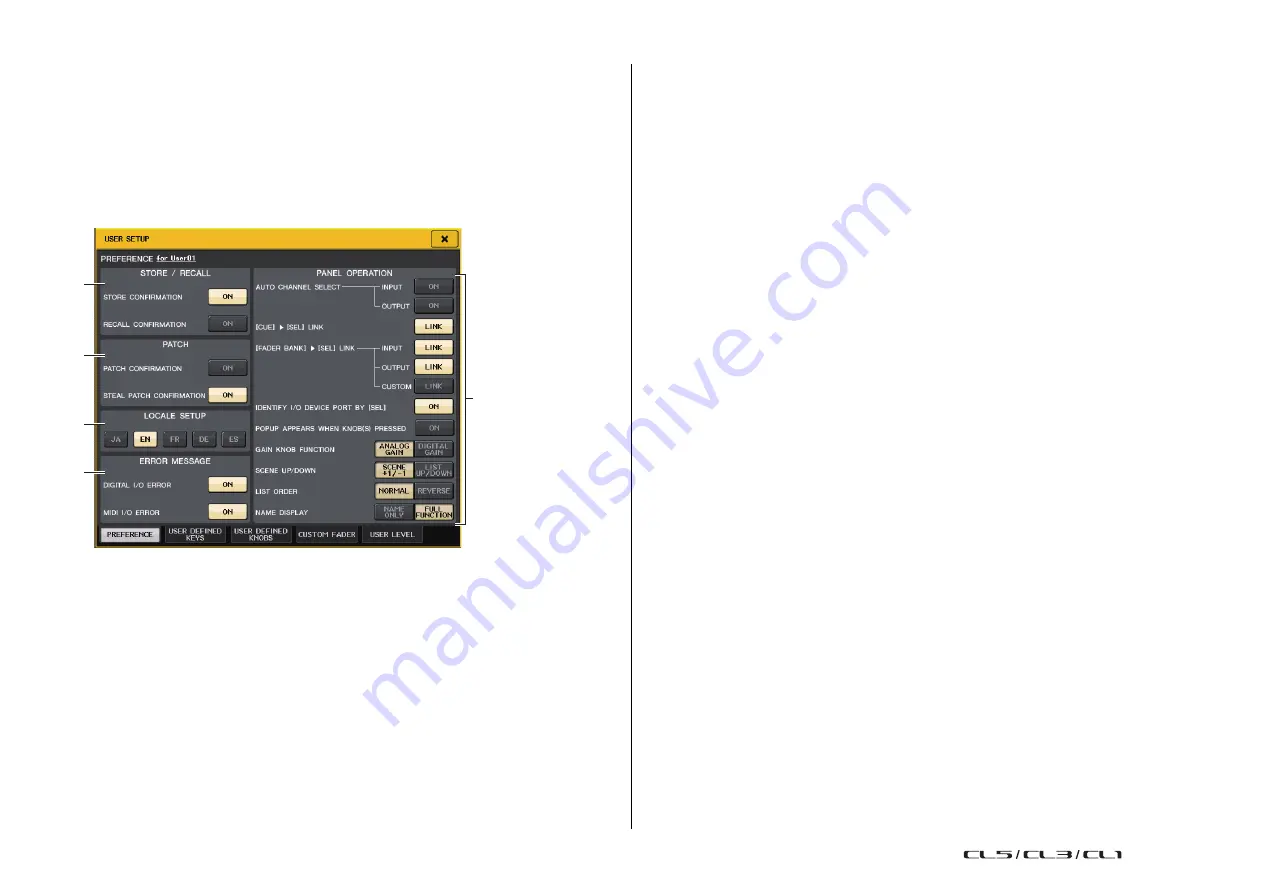
User settings (Security)
Reference Manual
168
Preferences
Follow the steps below to make various settings for the CL console operating environment, such as how
popup windows appear, and whether [SEL] key operations will be linked. These settings are changed
for the user who is logged-in, but if you are logged-in as the Administrator, you will also be able to
change the Guest settings.
1.
In the Function Access Area, press the SETUP button to access the SETUP screen.
2.
Press the SETUP button to open the USER SETUP popup window.
3.
Press the PREFERENCE tab to access the PREFERENCE page.
If you are logged-in as the Administrator, you can also turn on the FOR GUEST button in the
lower right of the screen to access the PREFERENCE for Guest page and make preference settings
for the Guest account.
This page includes the following items.
1
STORE/RECALL field
Enables you to turn on or off options related to scene store/recall operations.
• STORE CONFIRMATION
• RECALL CONFIRMATION
If these ON buttons are lit, a confirmation message will appear when you perform a Store or Recall
operation respectively.
2
PATCH field
Enables you to turn on or off options related to patch operations.
• PATCH CONFIRMATION
If this ON button is lit, a confirmation message will appear when you edit an input patch or output
patch.
• STEAL PATCH CONFIRMATION
If this ON button is lit, a confirmation message will appear when you edit an input or output patch
item that is already patched to a port.
3
LOCALE SETUP field
In the SAVE/LOAD screen or RECORDER screen, select JA if you want Japanese to be displayed.
(This does not select the Help language.)
4
ERROR MESSAGE field
Specifies whether error messages will be displayed.
• DIGITAL I/O ERROR
If this ON button is lit, an error message will appear when a digital I/O error occurs.
• MIDI I/O ERROR
If this is on, an error message will appear when a MIDI transmit/receive error occurs.
5
PANEL OPERATION field
Enables you to make settings for options related to panel operation.
• AUTO CHANNEL SELECT
Specifies whether the corresponding channel will be selected when you operate the [ON] key or
fader for the channel. You can set this parameter separately for INPUT (input channels) and
OUTPUT (output channels).
• [CUE]
[SEL] LINK
Specifies whether channel selection will be linked with cue operations. If the LINK button is on,
channels for which cue operations were performed will be selected.
• [FADER BANK]
[SEL] LINK
Specifies whether channel selection will be linked with fader bank selection. You can set this
parameter separately for INPUT (input channels), OUTPUT (output channels), and CUSTOM
(Custom fader bank).
If the LINK button is on, and you select the corresponding fader bank, the channel in that bank
that was selected most recently will be selected, and its [SEL] key will light.
• IDENTIFY I/O DEVICE PORT BY [SEL]
Specifies whether to enable a function that allows you to identify the I/O device port connected
to a channel by pressing the [SEL] key for that channel.
If this ON button is lit, pressing a [SEL] key on the panel will cause the signal indicator to flash
for the port of the I/O device that is assigned to the corresponding channel by the INPUT
PATCH/OUTPUT PATCH settings.
1
2
3
4
5






























